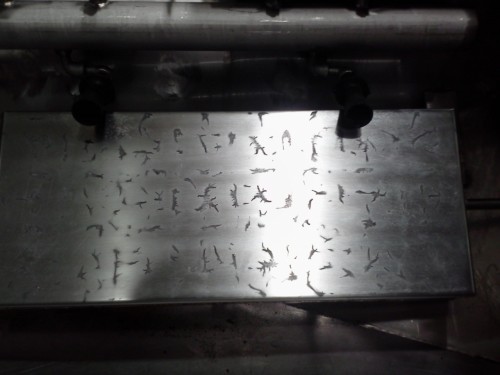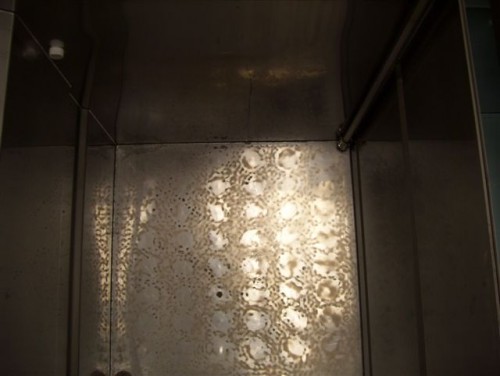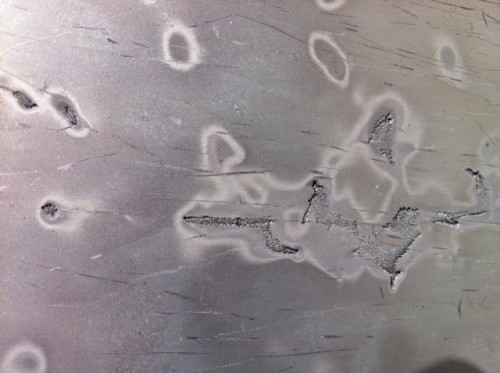Surface cavitation erosion of ultrasonic transducers is a topic that users and manufacturers of ultrasonic equipment would often rather not talk about – – but we must. The erosion of a transducer surface due to surface cavitation is inevitable over time. Its severity depends on several factors, some of which can be controlled and some of which can not and yet others that are total unknowns. The following pictures show examples of transducer surface cavitation erosion.
Surface cavitation erosion is the result of the intense forces created at the surface of the ultrasonic transducer as vibrational energy is transferred from the vibrating surface to the liquid in contact with it. In fact, metal is actually removed from the transducer surface as cavitation bubbles implode in contact with it. The effect is most severe on transducers operating at frequencies lower than 100 kHz. In general, the lower the frequency, the more rapid and severe the erosion will be. Once an initial erosion site has been established, it serves as a source for further erosion as cavitation bubbles attack the compromised surface.
As stated above, there are some factors that affect surface cavitation erosion that can be controlled –
Operating Time –
Surface cavitation erosion can not, of course, progress when the ultrasonic transducer is not operating. It makes sense that ultrasonic transducers should not be left operating when they are not needed, a practice not followed by all users.
Chemistry –
The chemistry being used can have a significant effect on the progression of surface cavitation erosion. Mild soaps and emulsifiers in low concentration generally show the slowest progression rate. High concentrations of caustic chemistry (sodium hydroxide for example) and, surprisingly, DI water are usually associated with faster progression rates.
Temperature –
There is a strong correlation between operating temperature and the rate of progression of cavitation erosion. In most cases cavitation erosion progresses much slower at lower operating temperatures. Operating temperatures over 180F should be avoided if possible. In the case of de-ionized water, the correlation between temperature and cavitation erosion seems to be less pronounced with severe cavitation occurring in some cases even at relatively low temperatures (< 100F).
Power –
Surface cavitation erosion progresses more slowly on ultrasonic transducers with low power density and on transducers operated at reduced power levels through the use of a power control.
As I mentioned at the outset, surface cavitation of transducers is inevitable. The output face of an ultrasonic transducer is a working surface and, just as the edge of a knife, will show deterioration with time. Although there is no sure-fire way to extend transducer life, many ultrasonic manufacturers offer alternatives that may extend transducer life in known severe applications. These include hard chrome plating of the transducer face, heavy gauge metal for the transducer face and alloys which have been shown to slow the rate of progression of cavitation erosion. None of these, however, has been demonstrated to completely stop surface cavitation erosion.
Transducer Life –
The onset of cavitation erosion can occur within the first few hours of operation. In some cases, however, transducers that have logged several thousand hours of operation show no cavitation erosion at all! In some cases the progression of erosion seems to plateau and stabilize once it reaches a certain point. Unfortunately, all of this is highly unpredictable. Depending on the application, the average transducer life before a transducer leaks due to surface cavitation erosion falls in the area of 6,000 hours of operation. For some users, 6,000 hours of operation is equivalent to 20 years of use while others may reach this window in less than a year. This difference makes it difficult for ultrasonic manufacturers to provide meaningful warrantees in terms of years of life expectancy. Certainly, if a failure occurs in an inordinately short period of time after installation (weeks for example) most ultrasonic manufacturers will replace the failed transducer under warranty.
Since surface cavitation is a known phenomenon, it makes sense for users of ultrasonic equipment to specify immersible transducers if possible in their equipment choice. Changing out the immersible transducers is much less costly and time consuming than rebuilding an entire tank that has failed with transducers that are mounted directly to the tank.
Surface cavitation erosion is something that, although an unpleasant prospect, users of ultrasonic equipment must be aware of. Hopefully the above has shed a little light on this topic.
– FJF –



 English
English Spanish
Spanish Chinese
Chinese Canada
Canada Mexico
Mexico United Kingdom
United Kingdom






